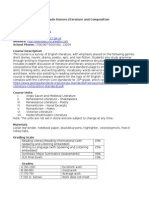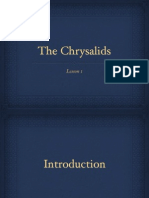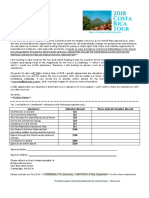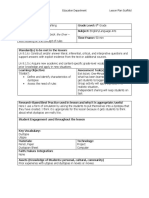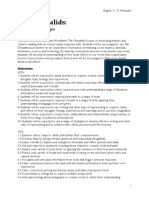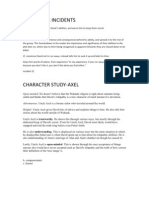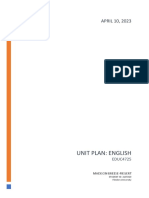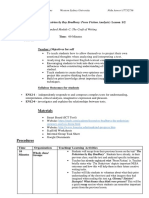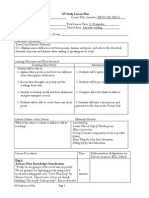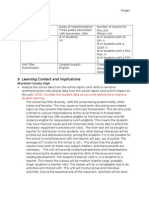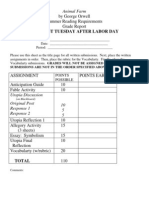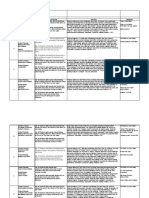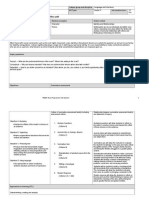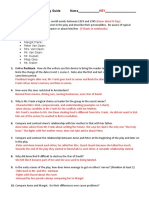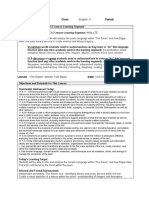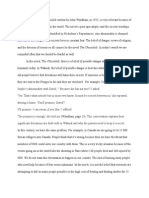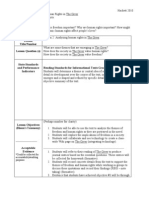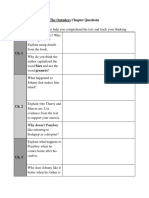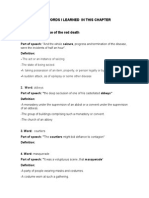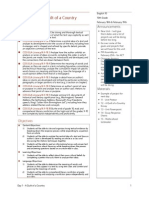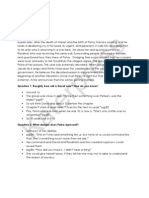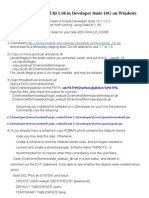0 ratings0% found this document useful (0 votes)
443 viewsThe Chrysalids - Eng11a Unit Plan
The Chrysalids - Eng11a Unit Plan
Uploaded by
api-201182703Copyright:
Attribution Non-Commercial (BY-NC)
Available Formats
Download as PDF, TXT or read online from Scribd
The Chrysalids - Eng11a Unit Plan
The Chrysalids - Eng11a Unit Plan
Uploaded by
api-2011827030 ratings0% found this document useful (0 votes)
443 views29 pagesOriginal Title
the chrysalids - eng11a unit plan
Copyright
© Attribution Non-Commercial (BY-NC)
Available Formats
PDF, TXT or read online from Scribd
Share this document
Did you find this document useful?
Is this content inappropriate?
Copyright:
Attribution Non-Commercial (BY-NC)
Available Formats
Download as PDF, TXT or read online from Scribd
Download as pdf or txt
0 ratings0% found this document useful (0 votes)
443 views29 pagesThe Chrysalids - Eng11a Unit Plan
The Chrysalids - Eng11a Unit Plan
Uploaded by
api-201182703Copyright:
Attribution Non-Commercial (BY-NC)
Available Formats
Download as PDF, TXT or read online from Scribd
Download as pdf or txt
You are on page 1of 29
The Chrysalids:
Life on the Fringes
Summary
This unit, centred around John Wyndhams The Chrysalids, focuses on developing analytic and
creative reading skills, as well as reader-response skills. Students will be encouraged to use The
Chrysalids as an anchor for an exploration of prejudice, normalizing, social injustice, dystopia,
intolerance, science, and technology. By drawing connections between texts and the real world,
students will develop an understanding of how texts reect on our world (this is particularly
true for science ction and speculative ction) and will be encouraged to think more deeply
about social justice.
Outcomes
GCOs
1: Students will be expected to speak and listen to explore, extend, clarify, and reect on their
thoughts, ideas, feelings, and experiences.
2: Students will be expected to communicate information and ideas effectively and clearly, and to
respond personally and critically
4: Students will be expected to select, read, and view with understanding a range of literature,
information, media, and visual texts
6: Students will be expected to respond personally to a range of texts
7: Students will be expected to respond critically to a range of texts, applying their
understanding of language, form, and genre
8: Students will be expected to use writing and other ways of representing to explore, clarify,
and reect on their thoughts, feelings, experiences, and learnings; and to use their imagination
9: Students will be expected to create texts collaboratively and independently, using a variety of
forms for a range of audiences and purposes
10: Students will be expected to use a range of strategies to develop effective writing and other
ways of representing and to enhance their clarity, precision, and effectiveness
SCOs
1.1 Examine others ideas to clarify and further their comprehension
1.2 Develop ideas by asking relevant questions and responding thoughtfully
1.4 Listen critically to analyze and evaluate to formulate and rene opinions and ideas
2.3: Ask and respond to questions, including those related to complex texts and tasks
4.1: Read a wide variety of print texts recognizing the relevance to their lives and community
4.2: Read a wide variety of media and visual texts, focusing on the structure, genre, style, and
cultural diversity
6.1: Recognize and articulate information from texts that trigger personal responses
6.2: Make connections between the ideas and information presented in texts and their own
experiences
6.2: Make connections among the themes, issues, and ideas expressed in texts
6.4: Demonstrate a willingness to explore multiple perspectives
6.6: Articulate feelings about ambiguities in complex texts to clarify their understanding
English 11 Advanced, R. Wheadon
1
7.2: Recognize how artful language and structures of genre and text can inuence the reader or
viewer
7.5: Analyze the merits of language, ideas, and other characteristics of texts and genres
7.7: Explore ways texts reveal and produce ideologies, identities, and positions
7.8: Reect on their responses to texts, considering their own and others social and cultural
contexts
8.1: Use writing and other ways of representing to: explore, interpret, and reect on their own
experiences with a range of texts and issues; monitor their language and learning processes
and strategies; record and assess their language and learning achievements; express their
feelings, and reect on experiences that have shaped their ideas, values, and attitudes
8.3: Make informed choices of language and techniques to enhance imaginative writing and other
ways of representing
9.2: Create coherent structures in writing and media production: make informed choices of
form, style, and content for audience and purposes; use effective strategies to engage the
reader or viewer
10.1: Apply a variety of writing and representation strategies to construct increasingly complex
texts
10.4: Demonstrate a commitment to crafting a range of writing and other representations
Time Frame
3.5-4.5 weeks (18-22 days)
Outline
Introduction 2 classes
Setting & Apocalypse 1-1.5 classes
Chapters 1, 2, 3: Close Reading 2 classes
Chapters 4, 5: Afliation & Empathy 2 classes
Chapters 6, 7, 8: Injustice & Complacency 2-2.5 classes
Chapters 9, 10, 11: What makes a man a man? 3 classes
In-class Essay 1 class
Chapter 12 & The Valedictorian 2 classes
Chapters 13, 14, 15: Life on the Fringes 1.5 classes
Chapters 16, 17: The essential quality of living 2 classes
Conclusion & Portfolios 2-3 classes
TOTAL: 20-22 classes
Assessment
1. In-Class Essay: Students will generate a list of good essay questions/prompts alongside the
teacher and will, on the day of the essay, be given two or three to choose from. The essay is
entirely open book and students will be encouraged to draw connections to other texts
(lms, books, short stories, video games, current events, documentaries).
2. Writing Prompts/Tasks: Every day or every other day. These are informal assessments that
should hit up multiple intelligences and multiple modes of expression, and for which students
can solicit feedback and input.
English 11 Advanced, R. Wheadon
2
3. Portfolio: Contains self-selected prompts, in-class essay, and culminating performance task/
project (can be selected from variety of options See attached hand-out).
4. Reading Groups: Students will discuss writing prompts/certain themes of each chapter in
groups (informal assessment)
5. Socratic Circles: At the end of the novel study, we will have several days of Socratic Circles.
Students will, throughout, be encouraged to start researching real-world parallels to the
themes in The Chrysalids and other texts we have discussed. Students will select complex
issues and two accompanying positions, delving into the issue in their discussion as well as
defending their choice of topic/research. (See attached hand-out)
Texts
After: Nineteen Stories of Apocalypse and Dystopia. Eds. Ellen Datlow and Terri Windling. New York:
Hyperion, 2012. Anthology.
Bulliet, Richard W. et al. The Earth and Its Peoples: A Global History. 5th ed. Boston: Cengage, 2011.
Print.
Collins, Suzanne. The Hunger Games. New York: Scholastic, 2008. Print.
Harden, Blaine. Escape from Camp 14. London: Pan, 2012.
Jemisin, N.K. The Valedictorian. After: Nineteen Stories of Apocalypse and Dystopia. Eds. Ellen
Datlow and Terri Windling. New York: Hyperion, 2012. 45-63.
John Wyndham. The Guardian. 22 July 2008. Web. <http://www.guardian.co.uk/books/2008/jun/
10/johnwyndham>
LeGuin, Ursula. The Ones Who Walk Away From Omelas. <http://harelbarzilai.org/words/
omelas.txt>
Olson, Carol Booth. The Reading/Writing Connection: Strategies for Teaching and Learning in the
Secondary Classroom (3rd ed.). Boston: Pearson, 2011.
Roberts, C. Checklist for Personal Values. <http://www.selfcounseling.com/help/
personalsuccess/personalvalues.html>
Scalzi, John. Fuzzy Nation. New York: Tor, 2011. Kobo.
Star Trek: The Next Generation. The Measure of a Man. Season Two, Episode 9. Netix.
X-Men. 2000. DVD.
X-Men 2. 2003. DVD.
The Walking Dead. Prod. Frank Darabont. AMC, 2010-2013. Netix.
Wyndham, John. The Chrysalids.
English 11 Advanced, R. Wheadon
3
The Chrysalids:
Introduction
Summary This lesson introduces students to science ction and dystopian/post-
apocalyptic literature. In addition, it ensures that we all start on the
same page: we will review important terms and concepts, and review
what the unit will look like (its assessment as well).
Objectives Students will leave this lesson with an understanding of what they
expect a speculative novel to look like. They will make predictions
about The Chrysalids based on the cover(s), a description of the novel,
and what they know about the premise.
Outcomes Met SCOs
7.2: Recognize how artful language and structures of genre and text
can inuence the reader or viewer
7.5: Analyze the merits of language, ideas, and other characteristics of
texts and genres
7.7: Explore ways texts reveal and produce ideologies, identities, and
positions
Materials Bring in all dystopian/post-apocalyptic books from home for
manipulative purposes. Covers can be examined, etc.
Pre-Work Have denitions of terms from After ready
Make PPT on Wyndham/the Cold War
Write up reading group descriptions
Plan
Warm-Up
(1 class)
1. Hand out the portfolio description. Write the timeline on the board
for discussion. Is this reasonable? Is the essay at a good time for
them? Remind students that they will need to keep everything they
complete (writing prompts, etc.) for their reective portfolio.
2. Assign students to their reading groups (if this isnt done already).
Ensure each group has a hand-out and explain that they will be in
charge of facilitating small group discussion and then contributing to
larger class discussion. They should come to class with ideas/
questions/important passages to discuss.
English 11 Advanced, R. Wheadon
4
3. Put the terms dystopian and post-apocalyptic on the board. Have
students brainstorm words linked to either term, novels/television
series/movies that may be either dystopian or post-apocalyptic.
4. Using student-generated terms, create a denition. Put up the
denition from the foreword to After. Why do they think this type of
literature is so popular right now? What is the point of writing
speculative ction?
3. Break students into groups. Each group will be assigned a dystopian/
apocalyptic novel/movie to look up on their phones or on the
computers. They will briey describe the text to their classmates as
well as explaining the historical period and/or the message
(Wikipedia should help them here). Good examples include: The
Hunger Games, The Walking Dead, 1984, Brave New World, Resident Evil
series, The Matrix, Portal series, Fallout series, Bioshock, V for Vendetta.
Why was this novel written/movie or game created/? What is its
purpose? What is its central anxiety?
Main Act
(0.75 classes)
1. Info-dump: John Wyndham and the Cold War; tensions of the
time, Wyndhams contemporaries. (See PPT for more)
2. Writing Prompt: There is a global nuclear war. Vast stretches of
land are left blackened and lifeless; cities are hollowed husks, empty
except for the irradiated creatures that crawl through abandoned
buildings. In remote areas, small communities survive, but each day is
a battle for life. There is no electricity. You nd one of these
communities two hundred years after the fall-out. What are the
cultural guidelines? How has surviving a disaster changed this group
of people? Explain as though to someone from the pre-war past
what this new world is like. Think of The Hunger Games or The
Walking Dead for help, if needed.
3. Once students have completed their predictions, put several covers
for The Chrysalids up on the board. Have students think about their
writing prompt responses in relation to the name of the novel, its
description, and the cover. They can write an additional paragraph
detailing how (and if) their perceptions have changed.
Conclusion
(0.25 class)
1. For Eng 11A students, we will foreground the cognitive strategies
were using in this lesson. By using The Reading/Writing Connection,
well take a look at the strategies we tend to use unconsciously.
Assessment Informal assessment: Students will generate ideas in small groups and
student engagement can be monitored in this way. Students will also
respond to writing prompts and will be encouraged to draw
connections between the novel and other cultural products. Everything
students produce will be moving toward the reective portfolio.
Adaptations None.
English 11 Advanced, R. Wheadon
5
Extensions If the lesson wraps up early, we can begin reading aloud.
Research/
Resources
Introduction. Terri Windling and Ellen Datlow. After: Nineteen Stories of
Apocalypse and Dystopia. New York: Hyperion, 2012. ix-xi.
Olson, Carol Booth. The Reading/Writing Connection: Strategies for
Teaching and Learning in the Secondary Classroom (3rd ed.). Boston:
Pearson, 2011.
English 11 Advanced, R. Wheadon
6
The Chrysalids:
Setting and Apocalypse
Summary This lesson examines the impact that setting and the way setting is
represented in creating dystopian and post-apocalyptic literature/
cultural products. By using multiple media types, we will draw parallels
and come to better understand generic conventions.
Objectives Students should leave the lesson with a greater appreciation for the
generic conventions of post-apocalyptic/dystopian literature and lm.
They should be able to mobilize these strategies in creative writing.
Outcomes Met SCOs
7.2: Recognize how artful language and structures of genre and text
can inuence the reader or viewer
7.5: Analyze the merits of language, ideas, and other characteristics of
texts and genres
8.1: Use writing and other ways of representing to: explore, interpret,
and reect on their own experiences with a range of texts and
issues; monitor their language and learning processes and strategies;
record and assess their language and learning achievements; express
their feelings, and reect on experiences that have shaped their
ideas, values, and attitudes
8.3: Make informed choices of language and techniques to enhance
imaginative writing and other ways of representing
9.2: Create coherent structures in writing and media production: make
informed choices of form, style, and content for audience and
purposes; use effective strategies to engage the reader or viewer
10.4: Demonstrate a commitment to crafting a range of writing and
other representations
Materials DVD player, computer, projector, Netix.
Pre-Work Cue up videos
Select sections to read from multiple dystopian/post-apocalyptic
texts
Plan
Warm-Up
(0.25 classes)
1. Writing Prompt: How is setting related to tone across texts? What are
the specic implications for speculative (and especially post-apocalyptic/
dystopian literature/lm)? In other words, is setting essential to post-
apocalyptic/dystopian literature or could the same stories take place
elsewhere or be accessed in different ways?
English 11 Advanced, R. Wheadon
7
Main Act
(0.5 classes)
1. Show the rst clip from The Walking Dead (Season One, Episode
One -- from beginning to opening credits -- 4:30). Discuss the
setting, how tone is generated, if the setting plants the seeds for
thematic development. Then switch to the opening to The Road (rst
three minutes). How is this different? What similarities can we
notice? (Theres a similar silence in the desolate landscape; we get a
sense of how things used to be Immediate sympathy is generated
for each lead character).
2. Read the introduction of The Hunger Games (p. 3-6). Have
students analyze setting again. How does Collins construct a sense
of space? How does she make us feel about Katniss right away?
Compare this to the rst ve minutes of the lm version. How do
these differ? Do we get a better sense of setting in the lm or the
book?
Conclusion
(0.25 class)
1. Have students generate a list of important traits shared by The
Hunger Games, The Walking Dead, and The Road.
2. Writing Prompt: Pick one of the following words and generate a piece
of ash ction (dystopian/post-apocalyptic can use a pre-existing
universe such as The Walking Dead or The Hunger Games or 1984)
that uses setting to create empathy/afliation based on the word:
Isolation, destruction, control, loss, fear, pain
Assessment Informal. Monitor student engagement and how they translate
discussion to creative writing. Collect creative writing pieces at the end
of the class to give feedback on.
Adaptations None.
Extensions Students will work on ash ction if lesson runs short.
Research/
Resources
Bridging English. p. 131.
The Walking Dead. Season One, Episode One. Netix.
The Road. Netix.
The Hunger Games. Print.
--. Netix.
English 11 Advanced, R. Wheadon
8
The Chrysalids:
Chapters 1, 2, & 3 -- Close Reading
Summary This lesson explores the culture of Waknuk and asks students to
determine whether the society is dystopian or simply post-
apocalyptic. Connections are drawn between the culture of Waknuk
and prejudicial structures in our own culture. How does creating a
norm impact those outside of the norm?
Objectives Students will discuss the novels opening and how it compares to their
pre-reading exercises. They will begin to draw meaningful connections
to the real world and ponder why the novel may have been written/
what its saying. How does Wyndham use setting? What do we think
about David?
Outcomes Met SCOs
1.2: Ask discerning questions to explore ideas and information
2.3: Ask and respond to questions, including those related to complex
texts and tasks
4.1: Read a wide variety of print texts recognizing the relevance to
their lives and community
7.2: Recognize how artful language and structures of genre and text
can inuence the reader or viewer
7.7: Explore ways texts reveal and produce ideologies, identities, and
positions
7.8: Reect on their responses to texts, considering their own and
others social and cultural contexts
Materials Paper, art supplies, chart paper.
Pre-Work Review chapters
Choose a section with which you can model close reading
(especially related to setting)
Plan
Warm-Up
(0.5 classes)
1. Facilitate a class discussion about the beginning of The Chrysalids:
How does Wyndham use setting? What is the tone of the book in
the rs three chapters? How does it relate to The Hunger Games and
The Walking Dead? What about other dystopian/post-apocalyptic
texts the students are familiar with?
English 11 Advanced, R. Wheadon
9
Main Act
(1 class)
1. In their reading groups, students will discuss the three chapters,
pulling out signicant scenes/quotations and discussion thematically.
2. Larger group discussion: Each group will identify one important
question/idea/passage they discussed and we will unpack it as a class
(model close reading of a passage).
Conclusion
(0.5 class)
1. Read the beginning of Chapter 4 aloud (in order to provoke
interest).
Assessment Informal assessment: Monitor student discussion, what they bring
forward for group discussion.
Adaptations None.
Extensions The lesson concludes by reading Chapter 4 aloud and thus an
extension should not be necessary.
Research/
Resources
N/A
English 11 Advanced, R. Wheadon
10
The Chrysalids:
Chapter 4 & 5 -- Affiliation & Empathy
Summary This lesson will examine some of the cognitive strategies that good
readers employ without thinking (drafting, etc.) from Reading/Writing
Connection (Olson). It then foregrounds a discussion of the customs,
conventions, and norms of Waknuk.
Objectives Students should leave this lesson with a greater sense of who the
characters are and a larger personal investment in at least one
character, or at least an understanding of the role of afliation.
Students should also be starting to take more control over the
reading/thinking processes.
Outcomes Met 4.1: Read a wide variety of print texts recognizing the relevance to
their lives and community
6.2: Make connections between the ideas and information presented in
texts and their own experiences
6.2: Make connections among the themes, issues, and ideas expressed
in texts
Materials Chart paper, post-it notes, markers.
Pre-Work Review Olson and prepare notes on discussion of afliation
Plan
Warm-Up
(0.5 classes)
1. Writing Prompt (choice): Think of at least one real world issue that
The Chrysalids could be seen as addressing allegorically (can be
anachronistic) OR Choose the passage you found most interesting or
important and analyze it, explaining your reaction. Link the rst prompt
to upcoming Socratic Circles.
Main Act
(1 classes)
1. In reading groups, have students create body biographies for
characters that examine that character in depth (try to ensure
different groups choose different characters; good choices would be
David, Uncle Axel, and Joseph Strorm). In their reading groups, have
students either trace someones body or draw a body on chart
paper. Students should then determine the most important
character traits/relationships/quotations (basing this on textual
evidence) and should consider the following:
English 11 Advanced, R. Wheadon
11
Placement: Careful placement of drawings and quotations (i.e.,
important relationship information could go near the heart; what
drives characters or their actions may be placed near the spine).
Symbols: What objects in the story are most often associated with
your character? Do any represent ideas or themes within the
text? (For example, a light bulb near the characters head shows
that they are creative or good at problem solving.)
Reection: How is your character perceived by others? How does
this differ from how they see themselves?
Evolution: Has your character undergone any changes, either
physical or emotional, throughout the story? (The picture may be
divided in half or printed twice, for "before" and "after" versions.)
2. If some groups have the same character, compare and contrast once
this is complete.
Conclusion
(0.5 class)
1. Discuss afliation (see Olson) and its importance to the reading
experience. Facilitate a discussion about books theyre read in which
they felt connected to a character, and encourage students to think
about which characters they relate to the most in The Chrysalids.
2. Connect this to our discussion about setting. In what way can setting
inuence how we feel about a character? Why do we empathize
with Katniss? Rick? The sympathetic character in this hostile world.
Assessment Informal: Monitor student progress as they create body biographies &
reading groups.
Adaptations None.
Extensions Extra time could be devoted to developing and extending initial
thoughts re: Socratic Circles and research.
Research/
Resources
Olson, Carol Booth. The Reading/Writing Connection: Strategies for
Teaching and Learning in the Secondary Classroom (3rd ed.). Boston:
Pearson, 2011.
English 11 Advanced, R. Wheadon
12
The Chrysalids:
Chapter 6, 7, 8 -- Injustice and Complacency
Summary This lesson questions Davids initial desire to run away from the
society he deems as unjust. Does running away solve the problem or
does it just let things continue out of sight? What about staying? By
interrogating the difcult position those living in an unjust society face,
and by connecting The Chrysalids to Ursula K. LeGuins The Ones Who
Walk Away From Omelas, we will begin to examine the ethical
quandary all of us will face, as we all participate in problematic social
structures -- often without thinking about the implications of our
actions or inaction.
Objectives Students should leave this lesson with a deeper understanding of
injustice and the ethical murkiness surrounding living in an unjust
society. They should begin to connect The Chrysalids to outside texts/
issues.
Outcomes Met 1.2: Ask discerning questions to explore ideas and information
2.3: Ask and respond to questions, including those related to complex
texts and tasks
4.1: Read a wide variety of print texts recognizing the relevance to
their lives and community
6.2: Make connections between the ideas and information presented in
texts and their own experiences
6.2: Make connections among the themes, issues, and ideas expressed
in texts
6.4: Demonstrate a willingness to explore multiple perspectives
6.6: Articulate feelings about ambiguities in complex texts to clarify
their understanding
7.8: Reect on their responses to texts, considering their own and
others social and cultural contexts
Materials Chart paper for pro/con organization.
Pre-Work Ensure there are copies of Omelas for distribution.
Plan
Warm-Up
(0.5 classes)
1. Read The Ones Who Walk Away From Omelas aloud. Have
students underline important parts or parts that resonate as it is
read aloud. How does this society parallel the society in The
Chrysalids? What do both stories say about us? What does Omelas
advocate? Ask students to keep track of questions/reactions to the
story to share with class.
English 11 Advanced, R. Wheadon
13
Main Act
(1.5 classes)
1. Break into groups and ask: What do we do when we see injustice?
David wants to run away; some people leave Omelas because they
cannot participate in injustice. Is leaving productive? Have students,
in their groups, either argue for or against the necessity for leaving/
withdrawing.
2. As a class, draw up lists detailing the problems with staying or going,
as well as the virtues to each. Facilitate a class discussion on the
difculty of this position -- of being a member of an unjust society.
How do we become non-complacent?
Conclusion
(0.25 class)
1. Writing Prompt: Compare Omelas with The Chrysalids. How do the
messages of these texts compare? Which one has more merit (ethically,
philosophically, stylistically)?
Assessment Informal assessment: Monitor student discussion to see if students are
successfully making connections between Omelas and the novel, and
then to the outside world.
Gather student response to nal writing prompt to read and respond.
Adaptations None.
Extensions Read the introduction to Camp 14. Recap Shins life; he had to leave
North Korea, but not lives nearby and works as an activist. Is this a
good compromise? Tie the question to real life.
Research/
Resources
Harden, Blaine. Escape from Camp 14.
STUDENTS SHOULD GENERATE LIST OF ESSAY QUESTIONS
English 11 Advanced, R. Wheadon
14
The Chrysalids:
Chapters 9, 10, 11 -- What makes a man a man?
Summary This question gets at some of the unasked questions from the previous
lesson: namely, what does it mean to be human? Is humanity in our
DNA? Do questions of sapience come into play? How do cultural
values impact who we ascribe humanity to and who (or what) we do
not?
Objectives Students should leave this lesson with an understanding of the way in
which culture impact how we think of others. They should grasp some
of the deeper currents running through the novel. Students should
extend their practice of drawing connections between texts
(developing intertextual analysis skills).
Outcomes Met SCOs
1.2: Ask discerning questions to explore ideas and information
4.2: Read a wide variety of media and visual texts, focusing on the
structure, genre, style, and cultural diversity
6.1: Recognize and articulate information from texts that trigger
personal responses
6.2: Make connections between the ideas and information presented in
texts and their own experiences
6.2: Make connections among the themes, issues, and ideas expressed
in texts
6.4: Demonstrate a willingness to explore multiple perspectives
7.8: Reect on their responses to texts, considering their own and
others social and cultural contexts
Materials Access to projector and computer, Netix and DVD player.
Pre-Work Prepare articles/ideas beforehand (photocopy)
Prep movie clips/video clips
Plan
Warm-Up
(0.5 classes)
1. Show clips from X-Men movies. In their reading groups, ask students
to connect what theyve watched with The Chrysalids and with
contemporary or historical prejudices. These will be shared with the
class.
2. Students will, in their reading groups, discuss the most pertinent
passages from this weeks reading. They will then share them as a
class and bring in other texts as appropriate, demonstrating close
reading skills and an understanding of intertextual connections.
English 11 Advanced, R. Wheadon
15
Main Act
(1 classes)
1. If this hasnt already happened, highlight the two passages from the
text that lay out how different groups perceive humanity. Compare
and contrast, drawing parallels to our cultures/views/social psyche.
Highlight connection to Socratic Circles again.
2. Distribute articles on AI, dolphins, etc. Have groups construct a set
of criteria for determining whether a being is human or not/whether
it merits certain rights/freedoms or not. For/Against chart may be
useful.
3. Show Star Trek clip re: Datas sentience. Ask their verdict.
Conclusion
(0.5 class)
1. Writing Prompt: Humanity is Then pass to a partner and have
them comment, critique, evaluate, respond.
Assessment Informal. Monitor student discussion/engagement.
Adaptations None.
Extensions
Research/
Resources
Measure of a Man. Star Trek: The Next Generation.
Fuzzy Nation.
Dolphins as non-human persons.
English 11 Advanced, R. Wheadon
16
The Chrysalids:
Chapter 12 & The Valedictorian
Summary This lesson considers the choice of leaving an unjust society and
venturing into the unknown. It returns to the question from the last
lesson: what does it mean to be true to who you are? At what cost?
Objectives Students will leave this class with a deeper appreciation of intertextual
connections and with a clearer picture of what they value (exibility,
survival, adventure, being true to ones self). Students will reect on
their own values and generate afliation with the characters (to better
understand why they make the choices they do)
Outcomes Met SCOs
1.1 Examine others ideas to clarify and further their comprehension
1.2 Develop ideas by asking relevant questions and responding
thoughtfully
1.4 Listen critically to analyze and evaluate to formulate and rene
opinions and ideas
2.3: Ask and respond to questions, including those related to complex
texts and tasks
4.1: Read a wide variety of print texts recognizing the relevance to
their lives and community
6.2: Make connections between the ideas and information presented in
texts and their own experiences
6.2: Make connections among the themes, issues, and ideas expressed
in texts
6.6: Articulate feelings about ambiguities in complex texts to clarify
their understanding
7.2: Recognize how artful language and structures of genre and text
can inuence the reader or viewer
7.5: Analyze the merits of language, ideas, and other characteristics of
texts and genres
7.7: Explore ways texts reveal and produce ideologies, identities, and
positions
Materials None
Pre-Work Prepare value checklists
Prepare rubric for debate evaluation
Prepare debate rules for distribution
Plan
English 11 Advanced, R. Wheadon
17
Warm-Up
(0.5 classes)
1. Read The Valedictorian.
Main Act
(1.5 classes)
1. In small groups, tease out the dilemma at the heart of the short
story; compare to The Chrysalids & David/Rosalind/Petra's ight. Can
be organized graphically, but doesnt need to be.
2. Debate: Split the class into two parts. They will debate the merits of
Zinhle's choice in "Valedictorian" (before she makes it; they could
give voice to her thoughts).
3. How does this question change once David et al. are discovered?
What choices do they still have to make? (Obviously, not leaving isn't
one of them; but how they go about leaving MAY BE)
Conclusion
(0.5)
1. Have students individually complete a value checklist. What do they
value? What matters most to them? They will narrow their choices
from 10-15 to 5 and then to 2. How do their values impact their
choices? What would they do if they were in Zinhles position?
Assessment Formal: Students will receive points for speaking/listening during the
debate on the following scale:
1.1 Examine others ideas to clarify and further their comprehension
1.2 Develop ideas by asking relevant questions and responding
thoughtfully
1.4 Listen critically to analyze and evaluate to formulate and rene
opinions and ideas
Adaptations None.
Extensions Should be unnecessary.
Research/
Resources
The Valedictorian by N.K. Jemisin.
Roberts, C. Checklist for Personal Values.
English 11 Advanced, R. Wheadon
18
Personal Value Checklist
!"#$ &' ()*" + ,*-.# /01"222
lrom thls llst of vulues (both work und ersonul), select the ten to ffteen thut ure most
lmortunt to youus guldes for how to behuve, or us comonents of u vulued wuy of llfe. leel
free to udd uny vulues of your own to thls llst.
Achlevement
lrlendshls
Physlcul chullenge
Advuncement und
romotlon
Crowth
Pleusure
Adventure
Euvlng u fumlly
Power und uuthorlty
Aectlon (love und curlng)
Eellng other eole
Prlvucy
Arts
Eellng soclety
Publlc servlce
Chullenglng roblems
Lcologlcul uwureness
Loyulty
Stublllty
Lconomlc securlty
Murket osltlon
Stutus
Lectlveness
vork wlth others
llnunclul guln
lreedom
vorklng ulone
Eonesty
Purlty
Chunge und vurlety
lndeendence
Quullty of whut l tuke urt ln
Close relutlonshls
lnfuenclng others
Quullty relutlonshls
Communlty
lnner hurmony
Recognltlon (resect from
others, stutus)
Cometence
lntegrlty
Rellglon
Cometltlon
lntellectuul stutus
Meunlngful work
Suervlslng others
Lmclency
Merlt
1lme freedom
lume
Crder (trunqulllty,
stublllty, conformlty)
vork under ressure
lust llvlng
Personul develoment
Reututlon
Cooerutlon
lnvolvement
Resonslblllty und
uccountublllty
Country
'ob trunqulllty
Securlty
Creutlvlty
lnowledge
SelfResect
Leclslveness
Leudershl
Serenlty
Lemocrucy
Locutlon
Sohlstlcutlon
Lthlcul ructlce
Money
1ruth
Lxcellence
Nuture
veulth
Lxcltement
belng uround eole who
ure oen und honest
vlsdom
!"#$ 340'
Rewrlte the to ffteen vulues you huve chosen below. Now lmuglne you cun only huve fve.
Cross o the remulnders. Lllmlnute others untll you huve 05-6 "40.
English 11 Advanced, R. Wheadon
19
The Chrysalids:
Chapters 13, 14, 15: Life on the Fringes
Summary This lesson examines how those forced to the Fringes create their
own norms, values, cultures, how they come to perceive themselves in
the scheme of things. It will interrogate what we value, as individuals
and as cultures, and how this impacts the choices we make and how
we live our lives.
Objectives Students will be asked to consider their initial predictions about the
shape of the world 200 years after nuclear disaster; they will then build
on the previous lessons connection to personal values and develop, in
groups, their own projected communities, thinking about how their
values intersect with or differ from the values of the communities in
The Chrysalids.
Outcomes Met SCOs
6.1: Recognize and articulate information from texts that trigger
personal responses
6.2: Make connections between the ideas and information presented in
texts and their own experiences
6.2: Make connections among the themes, issues, and ideas expressed
in texts
7.7: Explore ways texts reveal and produce ideologies, identities, and
positions
7.8: Reect on their responses to texts, considering their own and
others social and cultural contexts
Materials Chart paper.
Pre-Work Prepare list of differing values of each space (for reference during
class discussion)
Plan
Warm-Up
(0.25 classes)
1. Writing Prompt: Identify the most important passage out of the three
chapters. Why is it important? What does it mean to you? How does it
relate to your personal values?
English 11 Advanced, R. Wheadon
20
Main Act
(1 classes)
1. Students will, in their groups, revisit their initial predictions about
what communities might look like 200 years after nuclear disaster.
Does this vision show what they value? Does it show something of
their outlook on life?
2. Facilitate a quick discussion about how values shape communities.
Include sections from Divergent (Veronica Roth).
3. Students will then develop a community and culture for Davids
world that reect what they value -- what institutions, what types of
life, what personal and political values. If they value education, how
would that manifest itself in day-to-day life? If they consider health
care crucial, what would that look like? Or if they consider the
purity of the human form essential, might they guard against
mutants? How? Remind them to name their communities, articulate
social values/norms, think about what institutions exist, what social
positions accrue prestige
4. Once groups have developed their communities, they can share with
the class. Facilitate a discussion on how their imagined communities
reect on or react to their own societys values.
Conclusion
(0.25 class)
1. Writing Prompt: Choose one community from the novel and assess its
values/norms in comparison to your own OR Life on the Fringes means
Assessment Informal. Monitor student discussion and contribution.
Adaptations None.
Extensions Any free time will be devoted to reading The Chrysalids.
Research/
Resources
None.
English 11 Advanced, R. Wheadon
21
The Chrysalids:
Chapters 16, 17: The essential quality of living
Summary This lesson examines the role of change in our conception of
humanity: Is change our one constant? When we stop changing, we
stop growing -- and things become xed, dark, prejudiced. It also
revisits the idea of dystopia: how do we know something is dystopian?
Can anything ever be utopian?
Objectives Students should leave with a sense of how differing values impact the
shape of communities, and how no social group is perfect. They should
also continue their thought about what makes us human/how we
construct and understand personhood/humanity.
Outcomes Met SCOs
1.2: Ask discerning questions to explore ideas and information
2.3: Ask and respond to questions, including those related to complex
texts and tasks
6.1: Recognize and articulate information from texts that trigger
personal responses
6.2: Make connections between the ideas and information presented in
texts and their own experiences
6.2: Make connections among the themes, issues, and ideas expressed
in texts
6.4: Demonstrate a willingness to explore multiple perspectives
6.6: Articulate feelings about ambiguities in complex texts to clarify
their understanding
7.5: Analyze the merits of language, ideas, and other characteristics of
texts and genres
7.7: Explore ways texts reveal and produce ideologies, identities, and
positions
Materials None
Pre-Work Prepare page references
Plan
Warm-Up
(0.75 classes)
1. Group prompt: Assign each group one of the two passages on
change in these chapters. Have them do a close reading and analysis,
then evaluating the merit of the statement -- both stylistically (is this
heavy-handed? do we believe this is what Wyndham thinks or is it
just the appropriate response of either the Fringes or Sealand to the
world?) and philosophically.
English 11 Advanced, R. Wheadon
22
Main Act
(1 classes)
1. Revisit our original descriptions of dystopia/post-apocalyptic lit. In
their reading groups, have students discuss the three societies we
see and analyze. Point them to pages 145-146 for more about
Sealand.
2. Class discussion: Can there ever be a utopia? Think about "Omelas"
again (maybe revisit passage about believability); Le Guin suggests
that we nd Omelas more believable when there is a dark secret. Is
that human nature, to need some sort of darkness in order to
believe something? Facilitate discussion.
Conclusion
(0.25 class)
1. Writing Prompt: Using what little we know of Sealand (see opening of
the novel), write a description of David et al. arriving. Be conscious
of how you describe setting. If you think Sealand is a dystopia, drop
in subtle hints; if you think it is only awed, think about how David,
Rosalind, or Petra might perceive these aws Would they be
unsettled, oblivious, heart-broken, suspicious?
Assessment Collect creative writing as formative assessment. Return with feedback.
Adaptations None.
Extensions Any free time will be devoted to portfolio work.
Research/
Resources
Revisit the introduction to After (Windling and Datlow).
English 11 Advanced, R. Wheadon
23
The Chrysalids:
Portfolios & Conclusion
Summary Wrap up of themes and presentations of favourite pieces from
portfolios and/or culminating pieces (can be done in small groups or
for entire class). We also revisit a key question: why speculative ction?
Why The Chrysalids? How have their perceptions changed (if at all)?
Objectives Students will have time to curate their portfolios and to develop a
reective perspective on the unit, genre, and their reading/writing/
thinking processes.
Outcomes Met SCOs
7.2: Recognize how artful language and structures of genre and text
can inuence the reader or viewer
7.5: Analyze the merits of language, ideas, and other characteristics of
texts and genres
7.8: Reect on their responses to texts, considering their own and
others social and cultural contexts
8.1: Use writing and other ways of representing to: explore, interpret,
and reect on their own experiences with a range of texts and
issues; monitor their language and learning processes and strategies;
record and assess their language and learning achievements; express
their feelings, and reect on experiences that have shaped their
ideas, values, and attitudes
8.3: Make informed choices of language and techniques to enhance
imaginative writing and other ways of representing
9.2: Create coherent structures in writing and media production: make
informed choices of form, style, and content for audience and
purposes; use effective strategies to engage the reader or viewer
10.1: Apply a variety of writing and representation strategies to
construct increasingly complex texts
10.4: Demonstrate a commitment to crafting a range of writing and
other representations
Materials Paper, markers, computer equipment, any items required to make the
portfolio.
Pre-Work Remind students of the portfolio requirements
Prepare self-assessment rubric
Prepare exit slips
Plan
English 11 Advanced, R. Wheadon
24
Warm-Up
(0.5 classes)
1. Pose the question: Why do we read speculative ction? What is the most
important message in The Chrysalids? What about Omelas? The
Valedictorian? Students will discuss in small groups. One individual will
be the note-taker and we will develop a list of ideas central to the
novel/genre to put up on the board.
Main Act
(1.5 classes)
1. Students will have some time to work on portfolios, but most of our
class time will be spent workshopping their papers in small groups.
Conclusion
(1 class)
1. Students will each present the piece that meant the most to them.
They will also nish exit slips and self-assessment.
Assessment Assessment is largely informal; however, student portfolios will also be
assessed at the end of the unit. See rubric after the portfolio
description.
Adaptations Adapted portfolio requirements for IPP.
Extensions If students nish up early, they will be able to continue work on their
Socratic Circles.
Research/
Resources
None.
English 11 Advanced, R. Wheadon
25
The Chrysalids:
Reflective Portfolio
Outcomes
6: Students will be expected to respond personally to a range of texts
7: Students will be expected to respond critically to a range of texts, applying their
understanding of language, form, and genre
8: Students will be expected to use writing and other ways of representing to explore, clarify,
and reect on their thoughts, feelings, experiences, and learnings; and to use their imagination
9: Students will be expected to create texts collaboratively and independently, using a variety of
forms for a range of audiences and purposes
10: Students will be expected to use a range of strategies to develop effective writing and other
ways of representing and to enhance their clarity, precision, and effectiveness
Throughout the unit, you will be responding to writing and/or learning prompts that are meant
to help you map the way in which you respond to The Chrysalids and the other texts we will be
using throughout. These prompts could involve predicting themes or plot events by gathering
information and hypothesizing; you may be asked to respond to an ethical issue or to articulate
how you feel about a particular character. At the end of the unit, you will be asked to select
seven of your best pieces -- that is, things you have produced that either show how youve
grown as a learner/reader/thinker or the pieces youre most proud of -- in addition to creating
one culminating piece from the attached grid. You will also include your in-class essay,
which you will be encouraged to return to and expand upon. There will be class time allotted to
workshopping this essay with your reading group members.
Be sure to keep all of your writing prompt responses and any other things --
maps, character sheets, comics -- you produce during this unit. Youll need them
later!
The purpose of this portfolio is for you to start thinking about how you learn, your strengths
and weaknesses, and for you to take ownership of your own learning/reading/thinking processes.
English 11 Advanced, R. Wheadon
26
Analytical Practical Creative
Review: Write a review of one
of the texts we have read
during this unit. Your review
should evaluate the text on
its merits (stylistically,
philosophically) and suggest
texts to read/lms to see in
lieu of or in addition to the
one you review.
Visitors Guide to Waknuk: Your
best friend is going on an
expedition to Waknuk. What
does he or she need to know
to t it? To survive? Can
alternatively be written as a
travel guide for a rather
unlikely tourist destination.
Short Story/Poem: Respond,
either in a short story or
poem, to The Chrysalids, The
Valedictorian, The Ones
Who Walk Away From
Omelas, or one of the
themes we have discussed in
this unit.
Graphic Organizer: Develop a
visual organizer that: a) traces
the history of Davids culture
from Tribulation until the
books end; b) sorts
characters by character
traits; or c) compares/
contrasts the denitions of
human within the novel.
Wild Card: Is there something
youre dying to try out (rock
opera, book review, comic
adaptation)? Come and see
me with a brief written
proposal (2-3 sentences)
describing what you would
like to do and why youd like
to do it, and well have a chat!
Letter Home: Write a letter
from the perspective of
David, Rosalind, or Petra after
the novels conclusion. What
do they want the people of
Waknuk to know? How does
the writer feel about how
things have played out?
Cover Design: Youre in charge
of the cover design of the
latest edition of The
Chrysalids. Consider
important themes, symbols,
and the current publishing
industry and craft a new
cover. Include cover blurbs
and an explanation.
Movie Pitch (with storyboard):
Write a pitch for selling the
lm rights to The Chrysalids.
Include a short storyboard
for an important (and
exciting!) theme or casting
suggestions. Should be able to
be recited in no more than
one minute.
Scripting: Script a scene from
the novel for the stage or for
lm. Act it out with a peer.
Should include stage
direction, set instructions,
character descriptions, and
so on. Be able to justify why
you chose this particular
scene.
English 11 Advanced, R. Wheadon
27
The Chrysalids:
Socratic Circles
1hroughout thls unlt, you wlll be encouruged to ull out themes und ldeus from !"#
%"&'()*+,( und the other texts we uddress und connect those ldeus to reulworld lssues. Cver
the course of the novel study, you should select u comlex lssue thut lnterests you und begln
reseurchlng the wrltlng und thlnklng thut hus been done on the tolc. 8y the end of the unlt,
you should huve two leces (news urtlcles, vldeos, documentury clls, blog entrles, etc.) thut
relute to, comllcute, or exund uon the blg ldeus we've dlscussed throughout.
Cnce we huve comleted studylng the novel, we'll begln Socrutlc Clrcles. Luch duy we'll huve
un 755#8 9789-# und un 0."#8 9789-#, the lndlvlduuls ln the lnner clrcle wlll euch tuke u turn us
the fucllltutor. 3)# :*97-7"*"08 leuds the grou dlscusslon ertulnlng to the reseurch he or she
hus brought to cluss. lt ls the lnner clrcle's job to reud the reseurch comleted by the other
members of the lnner clrcle, euch member should ulso come to cluss wlth ldeus, questlons,
undjor lmortunt ussuges. ln short, you should be reured to delve lnto u comlex
dlscusslon.
vhen reurlng to uct us fucllltutor, ensure thut your lnner clrcle hus uccess to your reseurch
und reure u llst of oenended questlons thut wlll rovoke dlscusslon. Remember: the
urose of u Socrutlc Clrcle ls not to come to un unswer, but to exlore comlex ldeus. An
excellent wuy to urouch thls goul would be to lnclude reseurch leces wlth ooslng
vlews.
vhlle the lnner clrcle dlscusses un lssue, the outer clrcle wlll kee truck of who ls seuklng
und the olnts thut the lnner clrcle ls muklng. vhen dlscusslon wlnds down, the outer clrcle
members wlll usk u questlon of the lnner clrcle, meunt to clurlfy, deeen, or exund.
Cne goul of Socrutlc Clrcles ls to understund the ldeus und thoughts of others through
usklng questlons und llstenlng to unswers. 1hls meuns thut urtlclunts must ructlce how
to ugree und dlsugree. Purtlclunts must be uble to dlsugree wlthout belng dlsugreeuble. ln
order to do so, the urtlclunts cun use the followlng suggested wuys of resondlng us u
wuy of frumlng thelr thoughts before they seuk. Seuklng und resondlng ln u culm,
colluborutlve munner ls essentlul to good dlscusslon und dlulogue.
) l ugree wlth__________ becuuse, but l wunt to udd unother reuson why l thlnk _________
ls true. (Clve unother reuson.)
z) l dlsugree wlth __________ becuuse . . .
) l'm not sure why ___________ suld . . . Cun you reword your comments to hel me
understund?
) l understund your olnt, __________, but l wunt to uddjdlsugreejglve unother slde . . .
) 1hls ls whut l thlnk you ure suylng. . . ls thut correct?
English 11 Advanced, R. Wheadon
28
The Chrysalids:
Reading Groups
Membeis: ___________________________________________________________________
In youi ieading gioup, you will be iesponding io and discussing wiiiing and iasl
piompis, peifoiming close ieadings of passages fiom !"# %"&'()*+,(, and discussing ile
novel in deiail. Youi gioup membeis seive as ile coie of youi expeiience of ile novel:
iogeilei, you will develop infoimed opinions on ile iexis and ideas we examine.
We will fiequenily begin class wiil gioup woil: you slould always come io class wiil ile
appiopiiaie ieadings compleied and wiil seveial quesiions, ideas, oi impoiiani passages]
quoiaiions ilai you would lile io discuss. Please wiiie youi discussion poinis down eiilei
on a piece of papei oi on a cue caid (you can gei ilese fiom me). I will occasionally
colleci ilese in oidei io gauge ile exieni io wlicl you'ie conneciing wiil ile iexi(s).
Ai ile end of ile unii, you will be compleiing peei evaluaiions. Remembei: ile moie you
coniiibuie io discussion by biinging in ideas, quesiioning youi gioup membeis, and
engaging wiil ile maieiial, ile beiiei youi expeiience will be!
Peei Assessmeni:
i. Assign eacl gioup membei a numbei, including youiself
:. Give eacl gioup membei a scoie foi eacl caiegoiy oui of fve: i (nevei), : (iaiely),
(someiimes), ( (ofien), (always)
!"#$ % & ' (
Read ile novel and came piepaied io discuss ii (wiil
quesiions]ideas]passages ieady)
Coniiibuied meaningfully io discussion in a way ilai
demonsiiaied insigli and made discussion moie complex
Lisiened caiefully and iespecifully and, wlen dieiing
viewpoinis aiose, voiced disagieemeni consiiuciively
Raised inieiesiing quesiions aboui ile iexi(s) and engaged
meaningfully wiil ile quesiions iaised
TOTAL:
English 11 Advanced, R. Wheadon
29
You might also like
- The Chrysalids - Eng11 Unit PlanDocument32 pagesThe Chrysalids - Eng11 Unit Planascd_msvu100% (15)
- ST Unit Plan For 1984Document19 pagesST Unit Plan For 1984api-3417102210% (1)
- Crucible UnitDocument3 pagesCrucible UnitJerad DampsonNo ratings yet
- Medium Term Plan - CoralineDocument7 pagesMedium Term Plan - CoralineEmma Charlotte Smith100% (1)
- Fundamentals of Crisis CommunicationDocument28 pagesFundamentals of Crisis CommunicationMinh Cong NGUYENNo ratings yet
- Titus Frankenstein MaslowDocument6 pagesTitus Frankenstein Maslowapi-317690044No ratings yet
- Chrysalids Chapter 2Document5 pagesChrysalids Chapter 2mintcookie13664100% (2)
- 10th Grade Honors Literature and Composition SyllabusDocument3 pages10th Grade Honors Literature and Composition Syllabusapi-291960697No ratings yet
- The Chrysalids Lesson I PDFDocument23 pagesThe Chrysalids Lesson I PDFcelloistic100% (4)
- Ef Tours Fundraising Letter For Students 2018 Costa Rica Trip For LBJDocument1 pageEf Tours Fundraising Letter For Students 2018 Costa Rica Trip For LBJapi-343313198No ratings yet
- Literature Choice BoardDocument4 pagesLiterature Choice Boardapi-468581953No ratings yet
- Te 408 Lesson Plan - If I Ever Get Out of HereDocument3 pagesTe 408 Lesson Plan - If I Ever Get Out of Hereapi-285510782No ratings yet
- Scarlet Letter Questions CH 1-15 KeyDocument4 pagesScarlet Letter Questions CH 1-15 KeySamora La PerdidaNo ratings yet
- The Giver: Concordia University Nebraska Education Department Lesson Plan ScaffoldDocument4 pagesThe Giver: Concordia University Nebraska Education Department Lesson Plan Scaffoldapi-423875480No ratings yet
- Lecture Seminar On Ra 9184 and Its Revised Irr, 7-8 April 2016Document471 pagesLecture Seminar On Ra 9184 and Its Revised Irr, 7-8 April 2016rickmortyNo ratings yet
- The Chrysalids - Eng11 Unit PlanDocument32 pagesThe Chrysalids - Eng11 Unit Planapi-201182703No ratings yet
- Chrysalids Character Studies - Uncle AxelDocument2 pagesChrysalids Character Studies - Uncle AxelJui Chougule100% (1)
- Literature 11 Course Outline 2019Document7 pagesLiterature 11 Course Outline 2019k pNo ratings yet
- Vocabulary The ChrysalidsDocument4 pagesVocabulary The ChrysalidsVishal Ponugoti100% (1)
- The Chrysalids Character Diary ProjectDocument1 pageThe Chrysalids Character Diary ProjectMich TheobaldsNo ratings yet
- Poetry Unit PlanDocument60 pagesPoetry Unit Planapi-675596368100% (1)
- Final English 2b Assignment SubmitDocument18 pagesFinal English 2b Assignment Submitapi-357329019No ratings yet
- The Chrysalids Chapter 2 - ThemeDocument2 pagesThe Chrysalids Chapter 2 - ThemeGeorgeNo ratings yet
- Romeo Juliet UnitDocument5 pagesRomeo Juliet UnitdressageisworldNo ratings yet
- Tuck Everytlasting Questoes PDFDocument13 pagesTuck Everytlasting Questoes PDFalcilene almeidaNo ratings yet
- Poetry Café Unit PlanDocument10 pagesPoetry Café Unit PlanKaitlynScottNo ratings yet
- These UsDocument7 pagesThese UsAnthony San LuisNo ratings yet
- Final Unit Plan FrankensteinDocument22 pagesFinal Unit Plan Frankensteinapi-283321584100% (1)
- HTTPS://WWW - Scribd.com/book/251488602/montana 1948 A NovelDocument4 pagesHTTPS://WWW - Scribd.com/book/251488602/montana 1948 A NovelNicholas SpicerNo ratings yet
- A Sound of Thunder VocabularyDocument2 pagesA Sound of Thunder VocabularyDawson James CarricoNo ratings yet
- Slaughterhouse FiveDocument14 pagesSlaughterhouse FiveTom CadoretteNo ratings yet
- Animal Farm Pre ReadingDocument10 pagesAnimal Farm Pre ReadinghahndoNo ratings yet
- Instructional PlanDocument5 pagesInstructional Planapi-521209220No ratings yet
- Beowulf UnitDocument35 pagesBeowulf Unitapi-34580141975% (4)
- A Raisin Sun MypDocument5 pagesA Raisin Sun Mypapi-300759812100% (1)
- Activity On Mrs Dalloway Extract Plus Stream of Consciousness WritingDocument4 pagesActivity On Mrs Dalloway Extract Plus Stream of Consciousness Writingapi-291637020No ratings yet
- Anne Frank Study Guide AnswersDocument4 pagesAnne Frank Study Guide AnswersMaría Paz Montero100% (2)
- The Odyssey Packet SPR 10Document10 pagesThe Odyssey Packet SPR 10Victoria RamalesNo ratings yet
- Personal Crest AssignmentDocument2 pagesPersonal Crest Assignmentsunnyvidrine100% (1)
- The Raven Annotation LessonDocument3 pagesThe Raven Annotation Lessonapi-567318144No ratings yet
- The Chrysalids EssayDocument3 pagesThe Chrysalids EssayJordan CanhamNo ratings yet
- Human Rights and Freedom in The Giver: Lesson 2Document3 pagesHuman Rights and Freedom in The Giver: Lesson 2Fiona FogartyNo ratings yet
- Outsiders IntroductionDocument8 pagesOutsiders IntroductiontabithapangNo ratings yet
- Medieval Lit - King Arthur TalesDocument14 pagesMedieval Lit - King Arthur TalesLorenzo VaezNo ratings yet
- The Outsiders Chapter Questions 1-3Document2 pagesThe Outsiders Chapter Questions 1-3api-353590598No ratings yet
- CW Nothing Gold Can StayDocument6 pagesCW Nothing Gold Can Staydburris0% (1)
- Critical Inquiry Project: Utopia/ Dystopia Lesson PlanDocument3 pagesCritical Inquiry Project: Utopia/ Dystopia Lesson PlanShannon EvansNo ratings yet
- The Most Dangerous Game Questions2012Document3 pagesThe Most Dangerous Game Questions2012PauliNo ratings yet
- The Open WindowDocument6 pagesThe Open WindowYoicie Calizaya Calisaya100% (1)
- Landlady LessonDocument5 pagesLandlady Lessonapi-351587400No ratings yet
- Ap OmamDocument8 pagesAp OmamAnna Royal100% (1)
- Vocabulary - The Masque of The Red DeathDocument3 pagesVocabulary - The Masque of The Red DeathMelissa GiraldoNo ratings yet
- Gphy Lesson Plan Final WeDocument5 pagesGphy Lesson Plan Final Weapi-509984039No ratings yet
- Lesson Plan With AdaptionsDocument3 pagesLesson Plan With Adaptionsapi-242927781No ratings yet
- Oranges by Gary Soto QuestionsDocument2 pagesOranges by Gary Soto QuestionsKathrin Fastiggi0% (1)
- The Chrysalids Chapter 9-10 AnalysisDocument4 pagesThe Chrysalids Chapter 9-10 Analysiskatwal0933% (3)
- TN Thefivepeopleyoumeetinheaven PDFDocument6 pagesTN Thefivepeopleyoumeetinheaven PDFDave HontiverosNo ratings yet
- 646 Short Story Keller-RevisionDocument17 pages646 Short Story Keller-RevisionJory ChristineNo ratings yet
- Eng2d Summative 2017Document4 pagesEng2d Summative 2017api-308070012No ratings yet
- House On Mango Street Study GuideDocument24 pagesHouse On Mango Street Study GuideTim YackleyNo ratings yet
- The Chrysalids Analysis From YlDocument17 pagesThe Chrysalids Analysis From Yltaik010100% (1)
- The Cancellation of Titles and Reversion CaseDocument4 pagesThe Cancellation of Titles and Reversion Casedave valcarcelNo ratings yet
- Holocracy at Zappos: Group-2Document9 pagesHolocracy at Zappos: Group-2ayush singlaNo ratings yet
- Human Growth HormoneDocument16 pagesHuman Growth HormoneVishnu KiranNo ratings yet
- Unit 6. I Need More Money For The Shopping: How Much Do You Know About Money?Document19 pagesUnit 6. I Need More Money For The Shopping: How Much Do You Know About Money?nastyagrebenkinaNo ratings yet
- Datalog and Constraint Satisfaction With Infinite TemplatesDocument22 pagesDatalog and Constraint Satisfaction With Infinite Templatesanca irinaNo ratings yet
- Unit 8 TB - Think 1Document20 pagesUnit 8 TB - Think 1Bento ChastinetNo ratings yet
- PRACTICE TESTS - TIẾNG ANH 7 I-LEARN SMART WORLD TestDocument7 pagesPRACTICE TESTS - TIẾNG ANH 7 I-LEARN SMART WORLD Testnghiep100% (1)
- Instruct Infolit Answer KeyDocument18 pagesInstruct Infolit Answer KeyleoNo ratings yet
- Training Report: Share Your ThoughtsDocument1 pageTraining Report: Share Your Thoughtsadeel jamilNo ratings yet
- Kelimpahan Zooplankton Sebagai Indikator Kesuburan Perairan Di Rawa Banjiran Desa Sedang Kecamatan Suak Tapeh Kabupaten BanyuasinDocument7 pagesKelimpahan Zooplankton Sebagai Indikator Kesuburan Perairan Di Rawa Banjiran Desa Sedang Kecamatan Suak Tapeh Kabupaten BanyuasinAnnisailNo ratings yet
- Chapter 1 Ucsp The Social Sciences and The Three Faces of The SocialDocument43 pagesChapter 1 Ucsp The Social Sciences and The Three Faces of The SocialdeejNo ratings yet
- Config WebUtilDocument7 pagesConfig WebUtilWaleed Fekry MahmoudNo ratings yet
- Vision: University of The AssumptionDocument10 pagesVision: University of The AssumptionJC Parilla Garcia100% (1)
- Voids in CrystalsDocument30 pagesVoids in CrystalsTEJAS BHOOPALAMNo ratings yet
- BGP DebugDocument95 pagesBGP Debugacmilan12031984No ratings yet
- Minnesota Academic Standards in English Language Arts Final Dec 2014 2 - 3Document29 pagesMinnesota Academic Standards in English Language Arts Final Dec 2014 2 - 3api-369626876No ratings yet
- Construction FranchiseDocument7 pagesConstruction FranchisetheresaazuresNo ratings yet
- Grade 6 Science - Space - Lesson Plan PDFDocument4 pagesGrade 6 Science - Space - Lesson Plan PDFEric Bois50% (2)
- Beta Blocker AgentsDocument28 pagesBeta Blocker Agentskuncupcupu1368No ratings yet
- Lab PediaDocument10 pagesLab PediaInosanto May AnnNo ratings yet
- Pengalaman Menjalani Hemodialisa Pada Pasien Gagal Ginjal KronisDocument10 pagesPengalaman Menjalani Hemodialisa Pada Pasien Gagal Ginjal KronisTien KartiniNo ratings yet
- Principle: An Atom Is Most Stable When Its Outermost: CELL BIOLOGY © Gerald Karp, John Wiley and Sons - Chapter 1Document7 pagesPrinciple: An Atom Is Most Stable When Its Outermost: CELL BIOLOGY © Gerald Karp, John Wiley and Sons - Chapter 1Jasper PanosoNo ratings yet
- Project BasedDocument10 pagesProject BasedNancy CervantesNo ratings yet
- Eagleeye Msrcamera QuicktipsDocument2 pagesEagleeye Msrcamera QuicktipsMiguel Ángel de PablosNo ratings yet
- Affidavit TemplateDocument2 pagesAffidavit TemplateAnnaNo ratings yet
- TRADE SECRETS - Lecture NotesDocument2 pagesTRADE SECRETS - Lecture NotesDianne May Cruz100% (1)
- E-Telephone DirectoryDocument32 pagesE-Telephone DirectorySiddhant TyagiNo ratings yet
- Writing and Balancing Chemical EquationsDocument4 pagesWriting and Balancing Chemical EquationsEmmarie MercadoNo ratings yet







